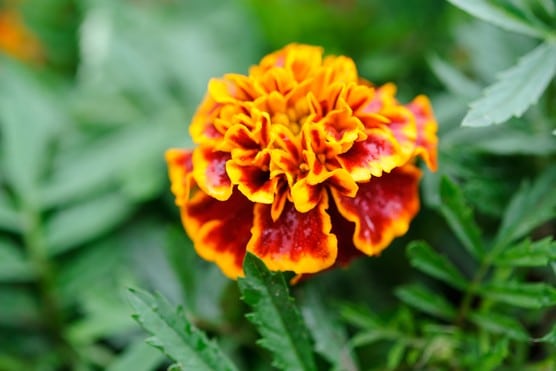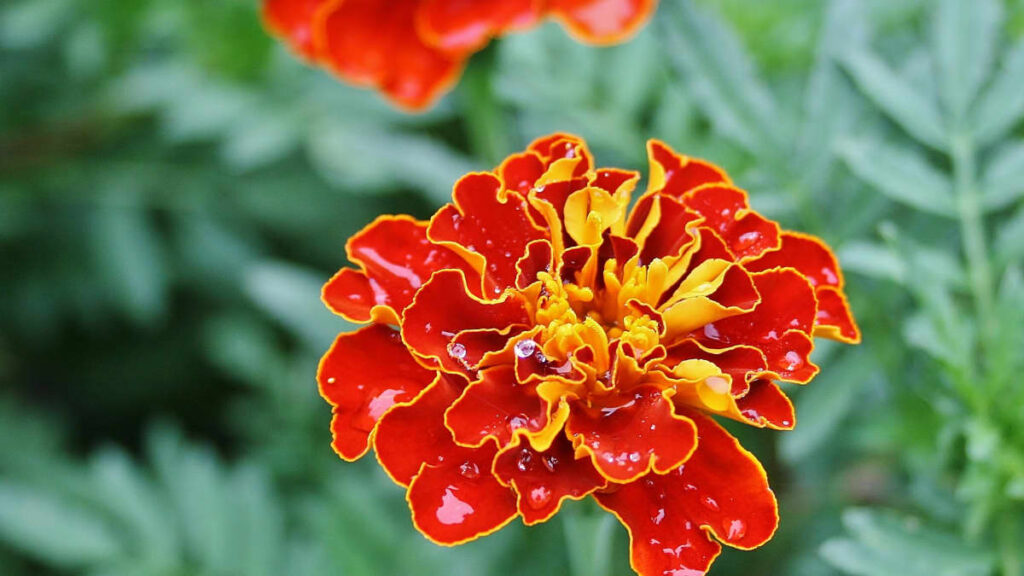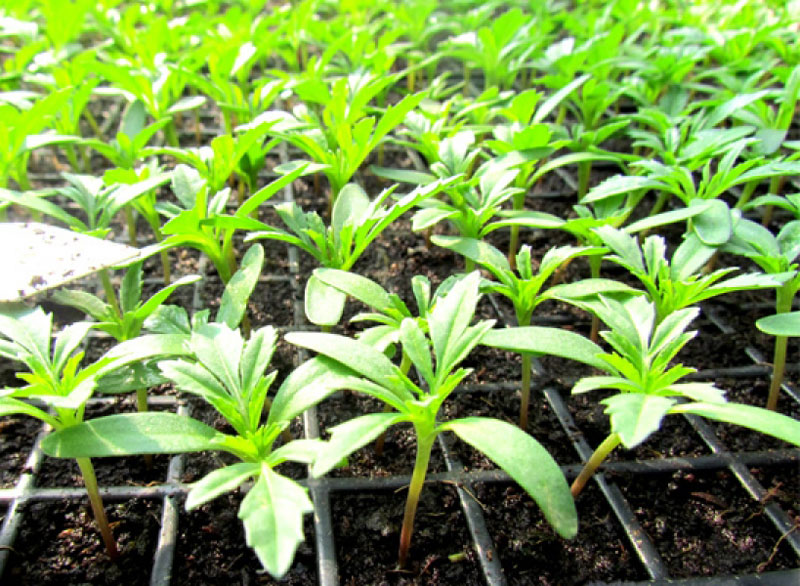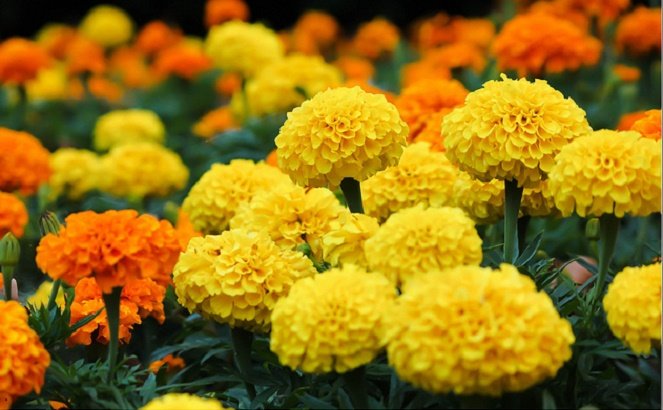Marigold flowers, heralded for their radiant hues spanning from vibrant yellows to deep oranges, stand as a testament to nature’s bounteous beauty. Native to the Americas, these flowers have permeated global gardens, earning acclaim not only for their aesthetic allure but also for their purported insect-repelling properties.
| Characteristic | Description |
|---|---|
| Scientific Name | Tagetes spp. |
| Life Cycle | Annual – Completes its entire life cycle within one growing season. |
| Flower Appearance | Daisy-like with variations ranging from single-petal flowers (e.g., signet marigolds) to double-petal blooms (e.g., African marigolds). |
| Bloom Size | Can vary significantly; from tiny blooms in signet marigolds to large 4-inch blossoms in African marigolds. |
| Foliage | Fern-like |
| Color Spectrum | Warm colors, predominantly yellows, oranges, and deep red hues. |
| Family | Aster family |
| Planting Medium | Typically planted from nursery starts or grown from seeds. |
| Growth Speed | Rapid; can achieve blooming maturity within a few months when planted from seeds. |
| Cultivation Strategy | For earlier outdoor blooms, seeds can be started indoors six to eight weeks prior to the last expected frost. |
What is the Marigold Flower?
Marigolds, vibrant symbols of sunshine and warmth, feature in gardens and landscapes around the world for their striking color and hearty resilience. Belonging to the genus Tagetes, marigolds are primarily native to North and South America, although their vibrant blooms and ease of growing have made them a favorite addition to gardens across the globe.
There are several species of the genus Tagetes, each with its own characteristics. For example, African marigolds (Tagetes erecta), with their tall stature and large, full blooms, are a popular choice for adding height and color to garden beds. French marigolds (Tagetes patula), on the other hand, are smaller but no less vibrant, producing a multitude of flowers that can range from golden yellow to orange and even deep red. Another variety, Signet marigold (Tagetes tenuifolia), is praised for its delicate, fern-like foliage and dainty clusters of small flowers.
Marigolds aren’t just grown for their beauty; they are also prized for their utility in the garden. Known for their natural insect repellent properties, these flowers are often grown alongside vegetables and herbs as a form of organic pest control. Compounds found in marigolds, especially pyrethroids, are effective in deterring many insects, making them valuable companion plants in organic gardening practices.
Furthermore, marigolds have cultural significance in many parts of the world. In Mexico, for example, they are an integral part of Dia de los Muertos (Day of the Dead) celebrations, where their vibrant petals are believed to guide the souls of the deceased back world of the living. Similarly, in Hindu religious ceremonies, marigolds are widely used for their symbolic meaning of passion and creativity.
Growing marigolds is simple, contributing to their popularity among gardeners of all skill levels. These hardy plants prefer well-drained soil and thrive in full sun, blooming from late spring until the first frost of fall. Marigolds can be grown from seeds sown directly in the garden or started indoors to bloom earlier. Regularly removing spent flowers will encourage the plant to continue blooming and maintain its shape.
In addition to their ornamental and practical uses, marigolds have found their way into various culinary and medicinal applications. Certain marigold species are edible, with their petals adding a splash of color and a slightly spicy flavor to salads, soups, and other dishes. Medicinally, marigold extracts, particularly from Calendula officinalis (often confused with Tagetes but belonging to a different genus), are used in creams and ointments for their anti-inflammatory and wound-healing properties.
The Different Types of Marigolds
Within the marigold family, three main types stand out, each with its own unique characteristics and charms: the African marigolds, French marigolds, and Signet marigolds. These varieties belong to the Tagetes genus and are celebrated for their vibrant colors, from sunny yellow to deep orange and russet tones, each bringing its own flair to the floral world.
African Marigolds (Tagetes erecta)
African marigolds, also known as American marigolds or Aztec marigolds, are the giants of the marigold family. Characterized by their tall stature, which can reach up to 3 feet in height, and large, full blooms, they are a splendid choice for adding a dramatic touch to garden beds and borders. Their flowers can be as large as 5 inches across and come in shades of yellow, orange, and white. Due to their size and striking presence, African marigolds are often used in mass plantings or as a focal point in garden designs.
French Marigolds (Tagetes patula)
French marigolds are more diminutive in size compared to their African counterparts, but they are no less impressive. Growing to about 6-12 inches tall, these marigolds are known for their prolific flowering and the diversity of their bloom types, which range from single to double forms. The colors of French marigolds are particularly varied, including yellow, gold, orange, and mahogany-red, often with multiple colors appearing on the same petal. These marigolds are ideal for edging paths and garden beds, and their compact size makes them perfect for container gardening as well.
Signet Marigolds (Tagetes tenuifolia)
Signet marigolds, or Tagetes tenuifolia, offer something a bit different in the marigold family. They are distinguished by their delicate, lacy foliage and a profusion of small, dainty flowers that bloom in shades of yellow, gold, and orange. The plants themselves are compact and bushy, making them excellent choices for borders, rock gardens, and as decorative edging. Signet marigolds are also noted for their edible flowers, which have a citrusy flavor and make a beautiful garnish for salads and desserts.
Each type of marigold brings its own special beauty to the garden, but they all share some common traits that make them beloved by gardeners. Marigolds are renowned for their ease of care, thriving in full sun and well-drained soil. They are also valued for their pest-repellent properties, making them excellent companion plants for vegetables and herbs.
Furthermore, marigolds play a significant role in cultural traditions around the world. In Mexico, the bright petals of marigolds are used to decorate altars and graves during Dia de los Muertos, symbolizing the sun and the brightness of life. In India, marigolds are a staple in wedding decorations, symbolizing brightness, positivity, and the sun.
How to Care Marigold
Marigolds, renowned for their resilience and vivid blooms, require minimal maintenance once they’ve taken root. Their robust nature not only makes them a staple for novice gardeners but also a practical choice for those keen on sustainable gardening practices.
Light
When considering the illumination requirements for marigolds, one of the pivotal aspects is ensuring they receive adequate sunlight. Light plays a quintessential role in determining not only the flowering frequency but also the overall vitality of the plant. Here’s what you need to understand about marigold’s light preferences:
To ensure optimal flowering and robust growth, you must position marigolds in locations that receive full sun. A sunlit environment is instrumental in prompting these plants to produce a profusion of blooms, ultimately enhancing their visual appeal. Conversely, if you place marigolds in areas with predominant shade, the plants will exhibit a tendency to grow leggy, stretching towards the light source. This elongated growth, apart from being aesthetically less appealing, can result in the plant bearing fewer flowers.
Water
Watering is a central aspect of plant care, and marigolds, while being relatively hardy, have specific hydration needs to be met, especially during their initial growth phase. Here’s a structured guideline on the water requirements for marigolds:
Upon planting marigold seeds or young plants, it’s paramount to ensure they receive consistent watering. This initial phase is critical for the plant’s establishment, and you should refrain from allowing the soil to remain dry for extended periods. Specifically, if the soil remains parched for more than a couple of days, it could impede the marigold’s growth trajectory.
Further, you have to be cognizant of the prevailing weather conditions. During exceptionally hot and sunny intervals, newly planted marigolds demand a heightened level of attention. Under these circumstances, you’re advised to water the plants daily, ensuring the soil retains a modicum of moisture to support the burgeoning roots.
However, as the marigolds mature and their root systems fortify, their dependence on frequent watering diminishes. A transition to drought-tolerant behavior is observable. Despite this increased resilience, for optimal flowering, it’s advisable to maintain a weekly watering schedule. This ensures the marigolds continue to produce vibrant blooms while benefiting from a stable moisture level.
Soil
When focusing on the soil requirements for marigolds, one quickly discerns that these plants exhibit a commendable adaptability. However, ensuring the right soil conditions can accentuate their growth and flowering potential. Here’s what you need to comprehend about the soil preferences for marigolds:
Marigolds exhibit a refreshing lack of capriciousness in terms of soil type. Essentially, you can plant them in any standard garden soil, and they are likely to thrive. However, there are a few considerations to bear in mind. While marigolds are relatively resilient, it’s crucial to ensure that the soil doesn’t veer towards excessive acidity. You should aim to maintain a soil pH that hovers around the neutral range, typically between 6.0 to 7.0. Monitoring and, if necessary, amending the pH will provide the marigolds with a conducive environment for growth.
Moreover, while many plants exhibit a predilection for nutrient-rich, organically dense soil, marigolds deviate from this norm. Surprisingly, they display a proclivity for leaner soils. Enriching the soil excessively with organic matter can, in fact, be counterproductive. Thus, you’d be well-advised to eschew excessive soil amendments when cultivating marigolds.
Temperature and Humidity
Marigolds possess an intrinsic affinity for heat. Indigenous to the warm climes of Mexico, these plants revel in summers and exhibit versatility by flourishing across a wide range of USDA zones, specifically from zones 2 to 11. However, it’s worth noting that during the peak of summer, especially in regions where temperatures soar, marigolds might display a subdued flowering pattern. But, as you transition into the latter part of summer and early fall, when temperatures mellow, marigolds rejuvenate, resuming their prolific flowering.
In terms of humidity, marigolds exhibit a commendable adaptability. They can persevere across varied humidity gradients. Nevertheless, you must be vigilant, especially during damp or humid summers. In such conditions, marigolds become susceptible to powdery mildew, a fungal malaise.
To mitigate this risk, it’s imperative to adhere to two primary strategies:
- Firstly, ensuring that marigolds are planted in locations with full sun exposure is pivotal. This not only facilitates optimal growth but also hastens the evaporation of surface moisture, minimizing fungal susceptibility.
- Secondly, when planning the layout, you should be intentional about spacing. Adequate gaps between marigold plants promote effective airflow, which, in turn, curbs the onset of fungal infections. Given their origins, marigolds inherently lean towards environments with drier air, making this adherence to spacing and sunlight even more critical.
Fertilizer
Contrary to conventional gardening wisdom, marigolds exhibit a limited appetite for supplemental fertilization. Unless you’re working with soil that’s conspicuously bereft of essential nutrients, these plants seldom mandate additional fertilizers. In essence, over-fertilization can be counterproductive for marigolds, potentially leading to lush foliage at the expense of flowers.
However, it’s worth noting that while marigolds might not crave external fertilization, they do have a predilection for regular deadheading. By promptly removing spent flowers, you can channel the plant’s energy more efficiently, encouraging the production of new blooms. This practice not only optimizes the flowering potential of marigolds but also bestows upon them a tidier and more organized appearance.
Propagating Marigolds
Marigolds, traditionally propagated via seeds, can also be propagated through stem cuttings, albeit this isn’t the most common method. While the convenience and efficacy of seed propagation render it the primary method for marigolds, vegetative propagation, specifically via stem cuttings, remains a feasible alternative. If you’re inclined towards this method, follow these structured steps:
- First, equip yourself with a pair of clean pruners. Employ them to snip off approximately 4-inch segments of the marigold’s green, supple stems. It’s advisable to select stems devoid of flowers or burgeoning flower buds for optimal results.
- Subsequent to the cutting, devote attention to the leaves. You should methodically remove all leaves populating the lower 50% of the cutting. Concurrently, ensure the excision of any existing flowers or flower buds.
- Having prepared the cutting, you should then immerse its base in a rooting hormone. This serves to expedite the rooting process. Once coated, position the cutting approximately 2 inches deep within a pot or tray. This container should be pre-filled with a suitably porous seed-starter mixture. Alternatively, a blend comprising potting soil, sand and perlite can be employed.
- With the cutting firmly ensconced, proceed to tamp down the surrounding potting medium. After ensuring a snug fit, moisten the medium. Thereafter, envelop the pot within a loosely fastened plastic bag. This serves as an ad-hoc greenhouse, fostering a conducive environment for rooting.
- For optimal rooting, place the encapsulated pot in a luminous location that’s simultaneously shielded from direct sunlight. Monitor the moisture levels, administering a light watering every four to five days to maintain the requisite dampness.
- Exercising patience is pivotal at this juncture. Over the span of several weeks, the cuttings will gradually establish roots. Upon discerning robust rooting, proceed to transplant these cuttings into more expansive pots teeming with standard commercial potting soil. It’s imperative to allow these transplanted cuttings to attain a level of stability and growth before their eventual relocation to the garden.
LotusBuddhas believes that by meticulously adhering to the outlined steps, you can harness the potential of vegetative propagation, nurturing marigolds that flourish and captivate with their vibrant blooms.
How to Grow Marigolds from Seed
Growing marigolds from seed is a rewarding endeavor that brightens any garden with vibrant colors and a touch of simplicity. These cheerful blooms are not only a feast for the eyes but also remarkably easy to cultivate, making them an excellent choice for both novice and experienced gardeners. Here’s a guide to growing marigolds from seed, encapsulating the process in clear, step-by-step instructions.
Choosing Your Seeds
Start by selecting the type of marigold you wish to grow. Whether you lean towards the tall and majestic African marigolds, the versatile French marigolds, or the delicate Signet marigolds, each variety brings its own unique beauty to your garden. Seeds can be found at your local garden center, through catalogs, or online seed suppliers.
When to Plant
Marigold seeds can be sown directly in the garden once the threat of frost has passed. For an earlier start, you can sow seeds indoors about 6 to 8 weeks before the last frost date. Marigolds enjoy warmth, so ensure the soil is sufficiently heated up if planting outdoors.
Sowing Seeds Indoors
- Prepare Your Containers: Use seed-starting trays or small pots filled with a well-draining seed starting mix. Ensure there are adequate drainage holes.
- Plant the Seeds: Sprinkle the marigold seeds on top of the soil. Cover them with a thin layer of soil—no more than a quarter inch deep. Marigold seeds do not require light to germinate, but they shouldn’t be planted too deep.
- Moisture and Warmth: Water the seeds gently to avoid washing them away. Keep the soil moist but not waterlogged. Placing the containers in a warm spot or on a heat mat can encourage germination.
- Light: Once seeds germinate, move the seedlings to a bright location or under grow lights. This prevents them from becoming leggy.
- Transplanting: When seedlings have grown a couple of sets of true leaves and are sturdy enough, harden them off by gradually introducing them to outdoor conditions. Then, transplant them to their final growing spot in the garden or larger containers.
Direct Sowing Outdoors
- Prepare the Site: Choose a spot in full sun with well-draining soil. Loosen the soil to about 8 to 12 inches deep and mix in some compost if available.
- Sowing: Plant the seeds a quarter inch deep and space them according to the final sizes of the variety you’re growing. Cover lightly with soil and water well.
- Care: Keep the soil moist until the seeds germinate. Thin the seedlings to prevent overcrowding once they’re a few inches tall, which promotes healthy growth.
Aftercare
Marigolds are relatively low-maintenance. Water them at the base to prevent fungal diseases and deadhead regularly to encourage continuous blooming. They are hardy and can withstand some neglect, but regular care will produce more vibrant and longer-lasting blooms.
Enjoying the Blooms
Marigolds will start to flower in about 8 weeks after sowing, providing a colorful display throughout the summer and into the fall. Besides their beauty, marigolds can help repel pests in the garden and are often planted near vegetable beds for this purpose.
How to Get Marigolds to Bloom
Getting marigolds to bloom prolifically is a goal every gardener cherishes. These vibrant flowers, known for their cheerful colors and ease of care, can light up any garden space. If you’re looking to maximize your marigold blooms, here are some tips and insights to help you achieve a garden bursting with color.
Proper Planting
First and foremost, the journey to abundant marigold blooms begins at planting. Marigolds thrive in full sun, requiring at least 6 hours of direct sunlight daily. Choosing a sunny spot is crucial for their growth and flowering. They’re not picky about soil but planting them in well-draining soil enriched with organic matter can give them a good start. When planting, give each marigold enough space to grow; overcrowding can lead to fewer blooms and a higher chance of disease.
Regular Watering
While marigolds are drought-tolerant once established, regular watering during their growing phase encourages healthy growth and flowering. Water your marigolds at the base to avoid wetting the foliage, which can lead to fungal diseases. However, be careful not to overwater, as marigolds do not like soggy conditions. A consistent watering routine helps the plants develop strong roots that support vigorous blooming.
Fertilization
Marigolds are not heavy feeders, but a light application of a balanced, all-purpose fertilizer at planting and perhaps once mid-season can support their blooming. Avoid high-nitrogen fertilizers, as they can lead to lush foliage at the expense of flowers. Instead, opt for a fertilizer with an equal balance of nitrogen, phosphorus, and potassium to encourage both growth and blooms.
Deadheading
One of the most effective ways to encourage marigolds to bloom continuously is deadheading, or removing spent flowers. Deadheading prevents the plants from putting energy into seed production and instead redirects it towards producing more blooms. Simply snip off the faded flowers just below the bloom to keep your marigolds looking neat and to stimulate further flowering.
Pest and Disease Control
Keeping your marigolds healthy is key to ensuring a bounty of blooms. Marigolds are relatively pest-resistant but can occasionally fall victim to aphids and other garden pests. Inspect your plants regularly and manage pests through natural remedies or appropriate insecticides if necessary. Additionally, avoid overhead watering to prevent fungal diseases, and ensure good air circulation around your plants.
Mulching
Applying a layer of mulch around your marigolds can help retain soil moisture, suppress weeds, and keep the root system cool. Mulch can also prevent soil-borne diseases from splashing onto the plants during heavy rains. A 2-inch layer of organic mulch, such as straw or shredded bark, is beneficial for marigolds.
Proper Spacing and Air Circulation
When planting marigolds, ensure they have enough space between them to grow without competition for nutrients, water, and sunlight. Proper spacing also promotes good air circulation, which is crucial in preventing fungal diseases that can hinder blooming.
Regular Monitoring and Care
Regularly check your marigolds for signs of stress or disease and address any issues promptly. Healthy plants are more likely to produce abundant blooms. Adjust care as needed throughout the growing season to keep your marigolds flourishing.
Common Problems with Marigolds
Marigolds are among the most cherished flowers in gardens worldwide, celebrated for their vibrant colors, ease of care, and pest-repellent qualities. However, like all plants, they can encounter a few hitches. Understanding these common problems and how to address them can ensure your marigolds thrive and continue to brighten your garden. Let’s explore some of the issues gardeners might face with marigolds and offer solutions to keep these cheerful blooms flourishing.
1. Pests
Although marigolds are known for their natural ability to repel certain garden pests, they are not entirely immune to insect troubles. Aphids and spider mites, in particular, can be attracted to marigolds. These tiny pests suck sap from the plants, weakening them and potentially spreading diseases.
Solution: Regularly inspect your plants for signs of pests. A strong spray of water from a hose can dislodge aphids and mites. For more severe infestations, neem oil or insecticidal soap can be effective, natural remedies that are safe for beneficial insects.
2. Powdery Mildew
Powdery mildew is a common fungal disease that manifests as a white or gray powdery coating on leaves and stems. It typically occurs in humid conditions, especially when plants are overcrowded and air circulation is poor.
Solution: Ensure your marigolds are planted with enough space between them to promote good air circulation. If powdery mildew appears, remove affected parts of the plant and dispose of them away from your garden. Fungicides can be used as a last resort, but often, improving conditions around your plants can prevent the spread.
3. Root Rot and Fungal Diseases
Marigolds are susceptible to root rot and other fungal diseases if they’re sitting in overly wet soil for extended periods. This usually happens due to overwatering or poor drainage.
Solution: Plant marigolds in well-draining soil and water them at the base, being careful not to overwater. If using containers, ensure they have adequate drainage holes. If root rot is suspected, affected plants should be removed to prevent the disease from spreading.
4. Poor Blooming
Sometimes, marigolds may struggle to bloom. This can be due to a few reasons, such as not enough sunlight, excessive nitrogen, or insufficient space to grow.
Solution: Make sure your marigolds are planted in a sunny spot where they receive at least 6 hours of direct sunlight daily. Use a balanced fertilizer sparingly to avoid an excess of nitrogen, which encourages leaf growth at the expense of flowers. Thin seedlings or transplant marigolds to ensure they have enough room to develop.
5. Legginess
Marigolds can become leggy, with elongated stems and sparse flowering, particularly if they’re not getting enough light or are too crowded.
Solution: Plant or relocate marigolds to a sunnier location if they’re not receiving enough light. If overcrowding is the issue, thinning the plants can help. Regular deadheading encourages bushier growth and more blooms.
Marigold Flowers in Feng Shui
In the intricate world of Feng Shui, the age-old practice of harmonizing one’s surrounding environment, marigold flowers occupy a symbolic place. Rooted in their vibrant hues and potent energy, marigolds are often associated with the sun’s positive yang energy, an energy known for its dynamic nature and capability to dispel shadows.
When you incorporate marigolds into your space, you are inviting in prosperity and auspiciousness. Their gold and orange shades are closely linked with wealth and abundance in Feng Shui, making them an ideal choice for those looking to bolster their financial and career sectors. Strategically placing marigolds in the wealth sector of your home or office can act as a magnet for prosperity.
Moreover, marigolds are potent tools for protection. In Feng Shui, these flowers are believed to possess the power to cleanse negativity and ward off harmful intentions. When positioned at entry points, such as windows or doors, marigolds act as barriers against unwanted energies and potential threats.
The act of gifting marigolds is also significant in Feng Shui. It is considered an auspicious gesture, symbolizing the giver’s wishes for the receiver’s happiness, success, and positive energy flow.
Incorporating marigolds in celebrations and ceremonies can enhance the positive energy of the occasion, welcoming happiness and joy. Especially during transitional phases, like moving into a new house or starting a new venture, marigolds can usher in auspicious beginnings.
FAQs
Do marigolds repel insects?
Marigolds have often been hailed for their supposed capacity to deter unwanted insects from neighboring plants, particularly in vegetable gardens. This belief, deeply entrenched in gardening folklore, suggests that the mere presence of marigolds can repel harmful insects. However, it is imperative for you to approach this claim with caution. Scientific scrutiny reveals a lack of substantial academic studies corroborating the notion that marigolds possess broad insect-repelling qualities.
What type of soil is best suited for marigolds?
Marigolds are relatively adaptable and can flourish in most garden soils. However, it’s crucial to ensure the soil pH is roughly neutral, ranging from 6.0 to 7.0. They do not necessitate particularly rich soil and can even thrive in leaner soils.
Can marigolds be grown indoors?
While marigolds prefer outdoor settings, they can be started indoors, particularly from seeds, around 6 to 8 weeks before the last expected frost. Upon germination and growth, they can then be transplanted outdoors.
Are marigolds perennial or annual plants?
Marigolds are true annuals, completing their lifecycle within one growing season. However, in certain regions, they may self-seed, giving the illusion of perennial growth.
Are marigolds edible?
Indeed, not all marigolds are created equal when it comes to edibility. Specifically, Signet marigolds, when incorporated into salads, offer a unique blend of vibrant color and a hint of spice to the palate. You may find the chopped flower petals enhance both the aesthetic and flavor profiles of the dish. However, you to note that other varieties of marigolds are not deemed suitable for consumption. Always exercise caution and ensure you’re using the appropriate type when integrating marigolds into culinary applications.












